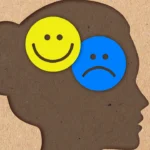What are Eating Disorders?
If someone has an eating disorder, it means that they experience a constant disruption in eating patterns that leads to an abnormal absorption of food. This causes impairment in their physical or psychological health.
A common misconception about eating disorders is that food is the core of the problem. However, there is usually a larger, deeper psychological issue at play that manifests as disordered eating.
Therapy.com is user supported. We receive a commission fee from purchases made through BetterHelp links.
Learn More
Examples include lack of ability to manage emotions, negative body image, or negative relationships with others.
Another misconception is that there are only two eating disorders: anorexia nervosa and bulimia nervosa.
However, binge eating disorder and avoidant restrictive food intake disorder also exist in the Diagnostic and Statistical Manual of Mental Disorders, Fifth Edition, Text Revision (DSM-5-TR) and can pose a severe risk to a person’s physical and mental health.
A third misconception is that athletes do not develop eating disorders yet, as many as 45% of female athletes and 19% of male athletes meet the criteria for an eating disorder.
Lastly, many think that eating disorders only affect a certain demographic: young, white women. However, these conditions can affect men and women of all ethnic backgrounds.
Like other mental health conditions, eating disorders have a stigma associated with them. It is a common opinion that people are to be blamed for their eating disorders and that they could stop the disordered eating if they really wanted to.
Experiencing stigma has been associated with a worsening of the condition and a greater resistance to treatment. This is unfortunate because treatment is crucial to helping someone recover.
Types of Eating Disorders
Anorexia nervosa and bulimia nervosa are two of the most-known eating disorders types.
Anorexia Nervosa
Anorexia nervosa is characterized by an intense fear of becoming fat, extreme self-criticism of one’s weight, and restriction of calories such that the person’s weight is less than what is considered the minimum for a healthy person of their age and sex.
There are two types of anorexia nervosa: restricting and binging/purging. The restricting type involves dieting, fasting, or excessive exercise and the binging/purging type involves binging on food and then purging it, such as by self-induced vomiting or the use of laxatives.
Bulimia Nervosa
Bulimia nervosa is defined as recurrently consuming significantly large amounts of food over a very short period. There is also a sense of a lack of control during such binging episodes.
To prevent weight gain, these episodes are followed by purging behaviors to compensate for the binging. Like with anorexia nervosa, bulimia nervosa also includes negative body image. Unlike anorexia, people with bulimia are rarely severely underweight and most are considered to be of normal weight.
Binge Eating Disorder
Binge eating disorder, on the other hand, does not have body dysmorphia as a criterion. Those with binge eating disorder typically do not have a distorted body image. Also, it includes binge eating episodes but without purging behaviors.
ARFID
Another eating disorder that does not involve a distorted body image is avoidant/restrictive food intake disorder (ARFID). This eating disorder is defined by a lack of interest in food, aversion to or fear of food, or aversion to the consequences of eating.
This is also associated with significant weight loss, nutritional deficiency, or interference with psychological or social functioning.
Orthorexia Nervosa
One form of disordered eating that does not exist in the DSM-5-TR but has been proposed to be included is orthorexia nervosa. Experts define this as an obsessive focus on what the person thinks is healthy eating.
This obsessive focus may lead to malnutrition, psychological distress, impairment in functioning, or self-worth or body image being dependent on compliance with self-defined healthy eating behavior.
Therapy.com is user supported. We receive a commission fee from purchases made through BetterHelp links.
Learn More
Symptoms of Eating Disorders
Eating disorder symptoms can vary depending on the specific disorder.
At the same time, a person may exhibit some common physical, emotional, and behavioral signs that they are struggling with disordered eating.
These can include:
- Depression
- Distress related to food or eating
- A sense of lack of control over one’s eating behaviors
- Eating alone out of embarrassment or wanting to hide one’s eating
- Self-esteem or self-worth being immensely based on body shape, size, or weight
- Significant weight loss
- Significant nutritional deficiency that may manifest with symptoms like hair loss, pale skin, or lack of energy
If these signs are present, early intervention can be important in helping to prevent disordered eating from worsening and starting on the road to recovery.
Food Therapy for Adults
Food therapy takes a comprehensive approach to helping adults with eating disorders.
A food therapist helps individuals develop a healthier relationship with food by addressing not only the intra- or interpersonal reasons for disordered eating but also by providing education on food and nutrition and helping to develop healthier eating patterns.
One such therapy strategy includes intuitive eating. This strategy includes honoring hunger, discouraging the labeling of any foods as “bad,” and allowing satisfaction with food intake.
It does not mean, however, encouraging someone to eat anything they want whenever they want. A qualified food therapist will support clients in maintaining an optimal balance of healthy or “always” foods and indulgent or “sometimes” foods.
Another type of food therapy is mindful eating. This encourages the person to be attentive to all aspects of food.
For instance, before taking each bite, the person is encouraged to observe the food’s look, smell, and structure closely.
Then after taking the bite, the person is encouraged to chew slowly and pay close attention to what they are tasting. Such mindfulness techniques can help a person slow down their eating and savor their food.
A third type of food therapy is exposure therapy, a form of CBT that can be effective in treating ARFID.
Therapy.com is user supported. We receive a commission fee from purchases made through BetterHelp links.
Learn More
Because ARFID is characterized by an aversion to food, gradual exposure to it can help the person tolerate food more and more as therapy progresses.
For example, the food therapist may sit in session with a closed container of soup until the person no longer experiences discomfort in the presence of it.
Next, the therapist may conduct a session with an open container of soup until the person becomes relaxed amidst the fragrance.
Then, the therapist may have the person hold the container of soup, and so on until the person can eat the soup comfortably.
Food therapy can be an important part of the overall treatment of eating disorders.
FAQs
Eating disorders are disrupted eating behaviors that alter food consumption and absorption and cause physical or psychological health concerns. They can develop in different ways depending on an individual’s experience.
Often, there is an underlying issue such as depression, sadness, anger, or negative relationships with others. If a person is not able to identify or manage their emotions, they may turn to disordered eating behaviors for temporary comfort.
The different types of eating disorders can be placed into one of two main categories: restriction of calories or compulsive eating. Anorexia nervosa and avoidant/restrictive food intake disorder (ARFID) involve calorie restriction. Restriction in anorexia is related to fear of becoming fat. In ARFID, calorie restriction is related to food aversion.
The second main category involves episodes of compulsive eating. Both bulimia nervosa and binge eating disorder fall into this category. The primary difference between the conditions is the characteristic binge/purge cycle of bulimia, which is absent from binge eating disorder.
Eating disorders involve irregular or rigid eating patterns but symptoms will vary depending on the disorder. Binging is a possible symptom of all eating disorders except for ARFID, and it involves eating an amount of food over a period of time that most people would consider to be excessive.
Purging is a symptom of bulimia nervosa and can also be a symptom of anorexia nervosa. Purging isn’t only self-induced vomiting.
It can also include excessive exercise and the use of laxatives, enemas, or diuretics. Negative body image, or self-worth being dependent on weight, is a symptom present in only bulimia and anorexia.
A host of additional physical, psychological, and social signs may be present in disordered eating.
Excessive weight loss, hair loss, irregular menstrual cycles, and heart arrhythmias, weakness, fatigue, and problems regulating body temperature are all symptoms of severe calorie restriction.
Persons who are purging due to an eating disorder may have scarring on their fingers and knuckles, esophageal erosions and hoarseness, weakness and fatigue, heart arrhythmias, and electrolyte imbalances.
People with eating disorders may also exhibit anxiety around and obsession with food and eating. They may become secretive or lie about their eating habits and they may avoid social situations where food is present. They may also prefer to eat alone or they may visit the restroom shortly after eating.
Recognizing the signs and symptoms of an eating disorder in yourself or someone you love can be the first step toward getting help. Early intervention is often key to preventing potentially life-threatening complications.
Food therapy helps a person to rebuild a positive relationship with food. It is a combination of nutrition advice, psychotherapy, and behavior change.
This combination helps to address the psychological, educational, and behavioral aspects of the person and their struggle with eating.
Treatment Options
The main first-line treatment for eating disorders is cognitive behavioral therapy (CBT).
CBT is developed from the assumption that distorted thinking or unhelpful core beliefs contribute to negative emotions and behavioral concerns.
The focus of therapy is to change unhelpful beliefs so that the person can experience less psychological distress and engage in healthy behaviors.
Therapy.com is user supported. We receive a commission fee from purchases made through BetterHelp links.
Learn More
Eating disorder treatment can be done on an outpatient basis, though for those with severe symptoms, residential treatment may be a better fit.
In any case, an interdisciplinary treatment team is best because it addresses all aspects and needs of the person: psychological, medical, nutritional, educational, and behavioral.
Various treatment options are available for eating disorders depending on the person’s needs, including different treatment settings and therapeutic approaches.





